After visiting Japan for the last thirteen seasons hunting for tree runs, taking the odd cat tour or lift-assisted snowshoe tour, I felt it was time to sample the backcountry properly. Here’s my take on what that experience is like for someone who usually has a healthy fear of unmanaged terrain and usually searches for powder in-bounds.
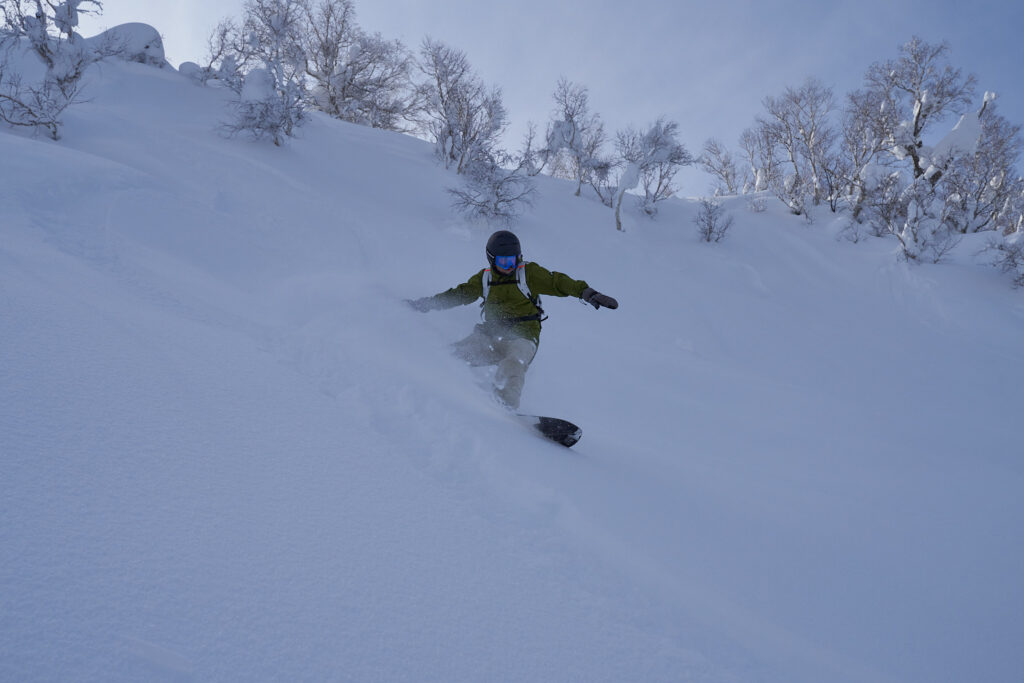
Just a 15-minute walk from the backcountry gate at Kiroro. Image: Aron Tarjani
We did two private guided day tours with Whiteroom on 29 January and 3 February 2025 (solo travellers can also join a group on one of their scheduled backcountry tours). My initial plan was to visit the backcountry at Asahidake on the first tour and then sample Whiteroom’s Resort Powder Discovery guiding at Rusutsu on the second tour, so we could discover where the hidden powder stashes are. I’d been to Asahidake before (with snowshoes) and I knew that there were endless powder runs accessible from very short hikes. It seemed like the perfect place to get started with splitboarding: Not too much uphill and plenty of laps in the cable car.
But, the weather gods did not shine on us and Asahidake was declared windswept, crusty and horrible by our guide, so we diverted to the backcountry at Kamui Ski Links, about an hour’s drive north from Furano. Kamui is a fantastic little resort with a big future ahead of it.
When booking a backcountry guide for the first time, it’s very tempting to do what I did, and say: “I want to go to this specific location and do a particular thing”. It makes sense. If your accommodation is close to a renowned backcountry spot, you’ve read a lot about it, or your friends have been there, you’ve seen videos, you’ve planned a year ahead for it, so you really want to do it. But this probably isn’t the best way to approach guiding, especially when you’re starting out and if you’re somewhere like Hokkaido, where the weather can be completely different just an hour’s drive away. The human traffic in a certain backcountry spot can also be very different depending on the last time it snowed, the day of the week, when the gates were last open, and, of course, the current avalanche risk.
Part of the benefit of having a knowledgeable guide at your disposal is that they can pick the best spot for the day. Be honest and detailed about your needs and limitations, but try not to get hung up on location.
Tour 1: Kamuiyama Backcountry
On the morning of the tour, we met our guide Greg Young at the Whiteroom Après cafe and bar in Furano, which serves as a meeting place for tours in the area and the pick-up point for any touring rental gear (the skier in our group had his own gear). Greg grew up in Australia, has been guiding in Furano since 2013 and has NZMSC Avalanche Pro 1, NZSIA 2, and Remote First Aid certification.
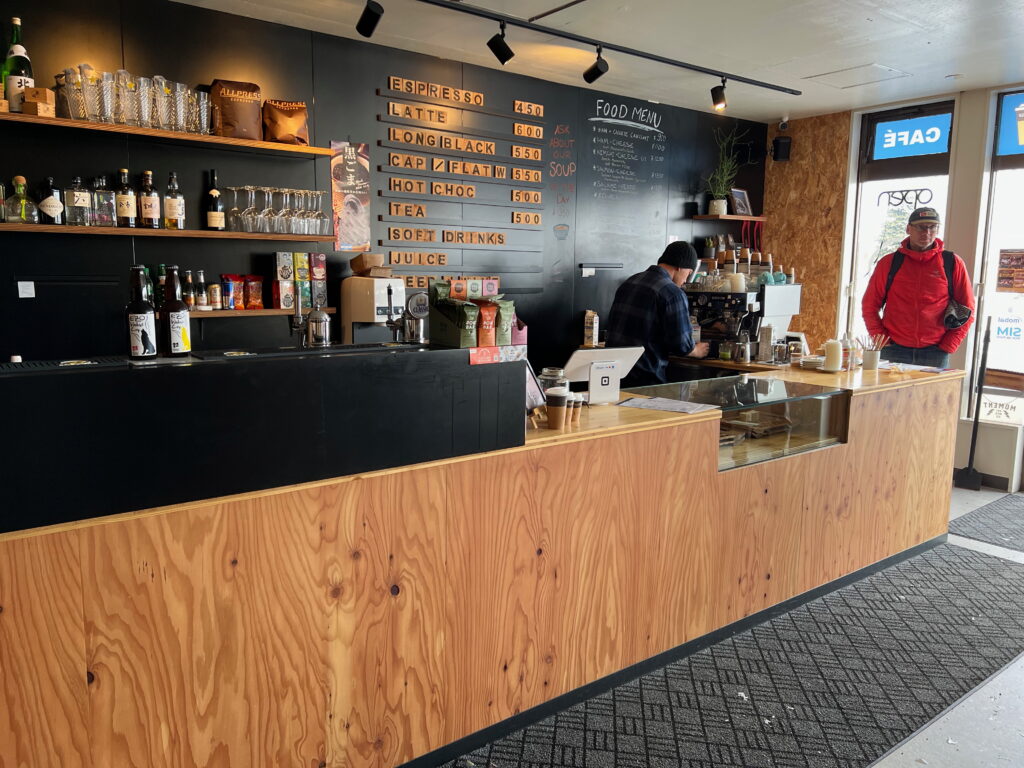
The Whiteroom Après cafe and bar in Furano (that isn’t Greg)
Having given our specs when booking, our rental splitboards were ready for pickup: a Weston Riva 147, Weston Backwoods 160 and Weston Backwoods 167W with Spark R&D bindings – all high-end gear in top condition.
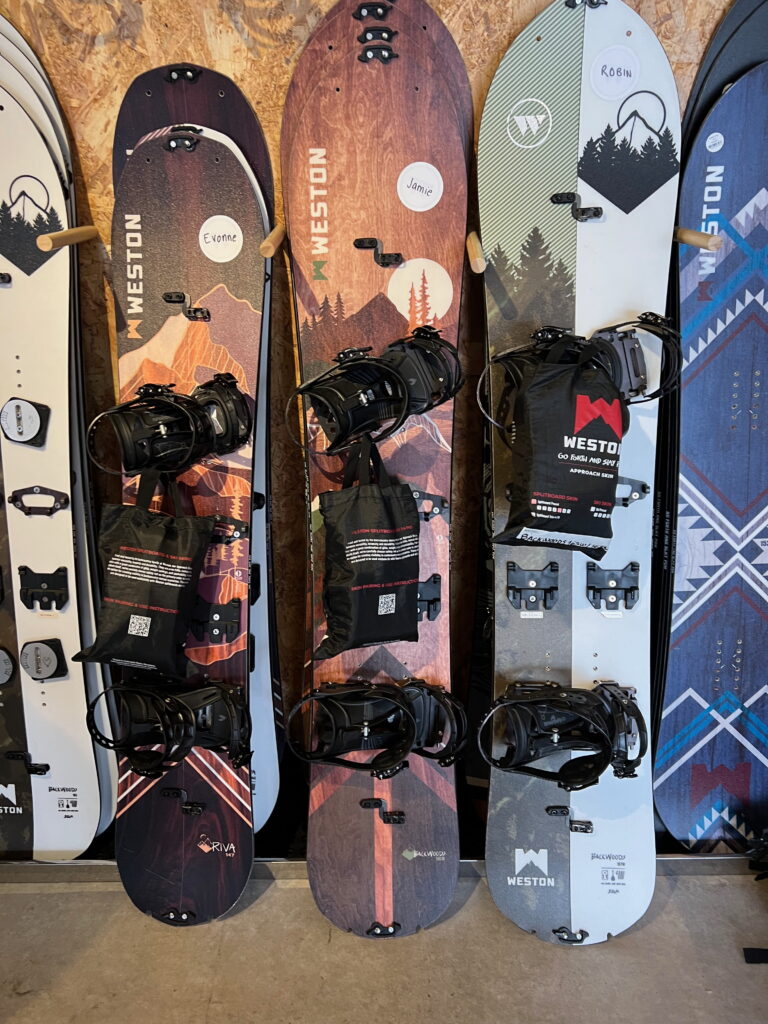
“High-end gear in top condition”
At Kamui Ski Links, there had been one or two inches of snow, the sun was poking out, and the wind was light. As it turns out, this was perfect weather and conditions for an introduction to splitboarding. Without it, no doubt we would have struggled (more) when it came to hiking in the deep stuff later in the week.
We took the lift to the top and got a quick lesson from Greg in how to transition: unclipping the bindings, separating the halves of the board, and how to unpack and stick on the skins. For those who don’t know, the skins are directional and allow you to walk uphill and slide downhill, just like traditional animal skins. They stick onto the skis with a very tacky glue that allows you to peel them off with a bit of effort.
I was totally new to this. The gear seemed very well designed, and it was pretty easy to learn the process. The boards slot together with two interlocking teeth that are fixed with a buckle that flips over, and then there are two latches at the nose and tail.
The bindings are ingenious. You just flip up a plate under the top area and slide them off the base plate. To enter touring mode, locate two pins and slide them on sideways. It’s very easy to do in the sunshine (but not so easy if it’s snowing and cold).
Greg also gave us some tips on layering and gear. The main takeaways from this were making sure you don’t get too hot and sweaty when you’re going uphill by stripping off layers and removing your helmet, and making sure you have appropriate gloves that are warm enough but enable you to deal with the fiddly parts of transitioning. Many guides seem to favour the cheaply available insulated rubber-coated work gloves when transitioning.
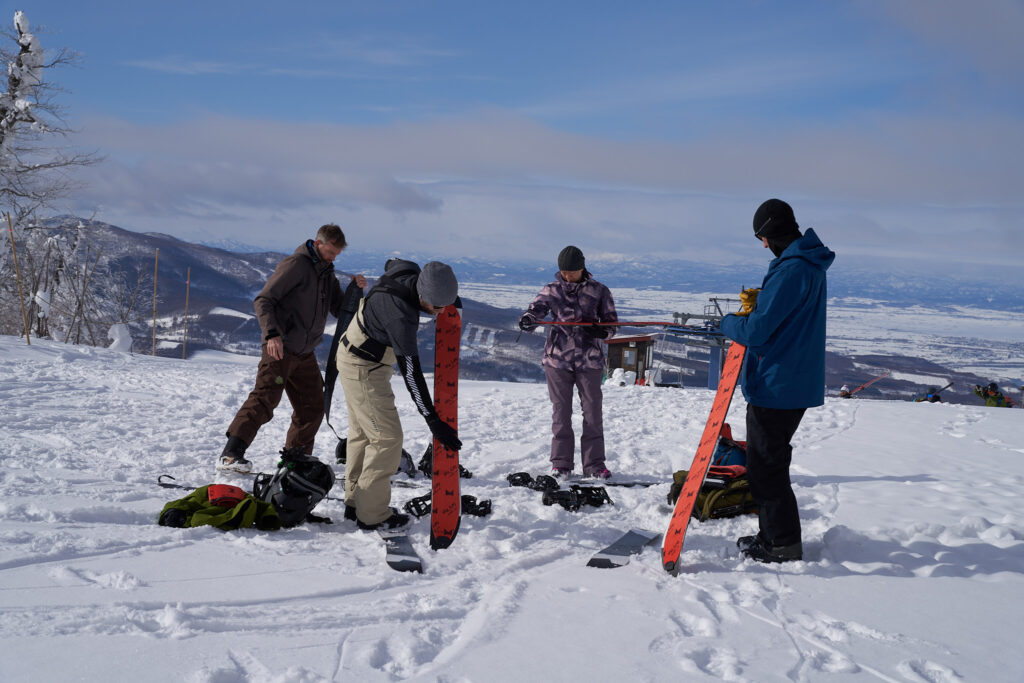
Learning how to apply skins to a splitboard. Image: Aron Tarjani
There are no official backcountry gates at Kamui Ski Links, but it isn’t roped off. The ski resort is on the north-west slopes of Kamuiyama mountain peak, and we hiked along a fairly flat ridge on the north side of the summit, past some communication towers, to access the backcountry on the north-east side of the mountain.
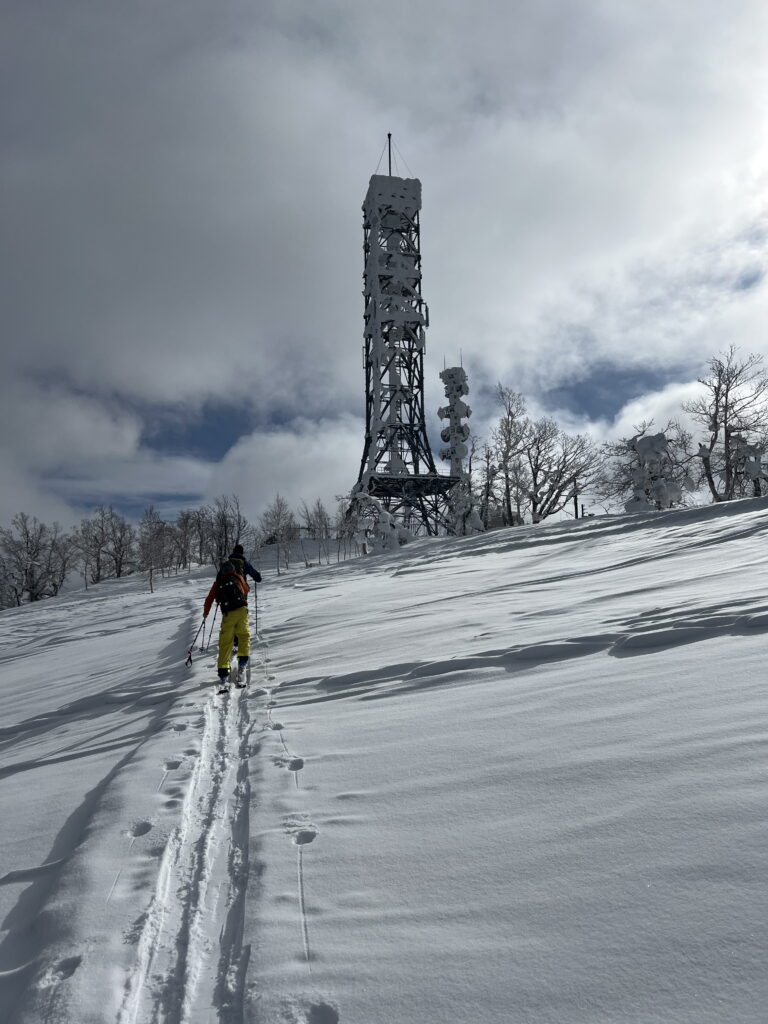
Hiking across the north ridge of Kamuiyama mountain peak. Image: Robin Watts
First impressions were that moving along on the splitboards on the flat in shallow snow was very easy. If you have any experience with downhill skiing or cross-country skiing, it will feel natural. The way the skins slide and then grip is super efficient. Compared to snowshoeing, it felt light and far less cumbersome than carrying a snowboard on your back. We were quickly gliding along with our heads up and enjoying the scenery.
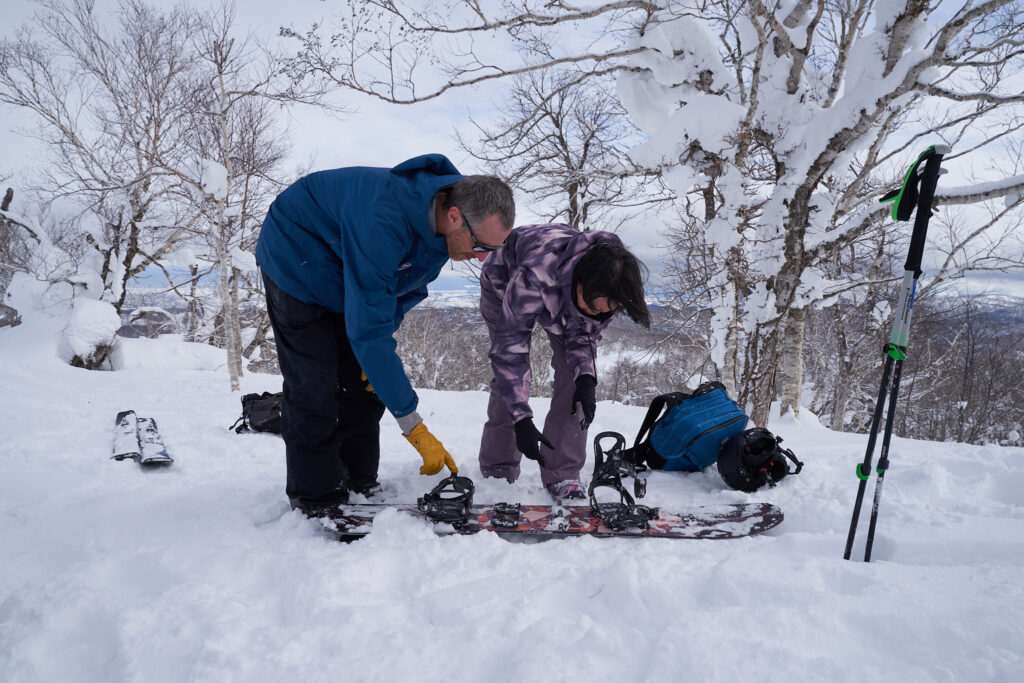
Setting the bindings correctly for the first descent. Image: Aron Tarjani
After a short 30-minute non-taxing hike, we transitioned back to riding mode for the first descent. Again, reassembling the snowboard was straightforward. The bindings are surprisingly easy to slide on and off. Just make sure you don’t mix up the right and left, and always ensure you switch the forward lean adjuster from touring mode to riding mode – otherwise, you’ll fall on your back when you make a heelside turn.
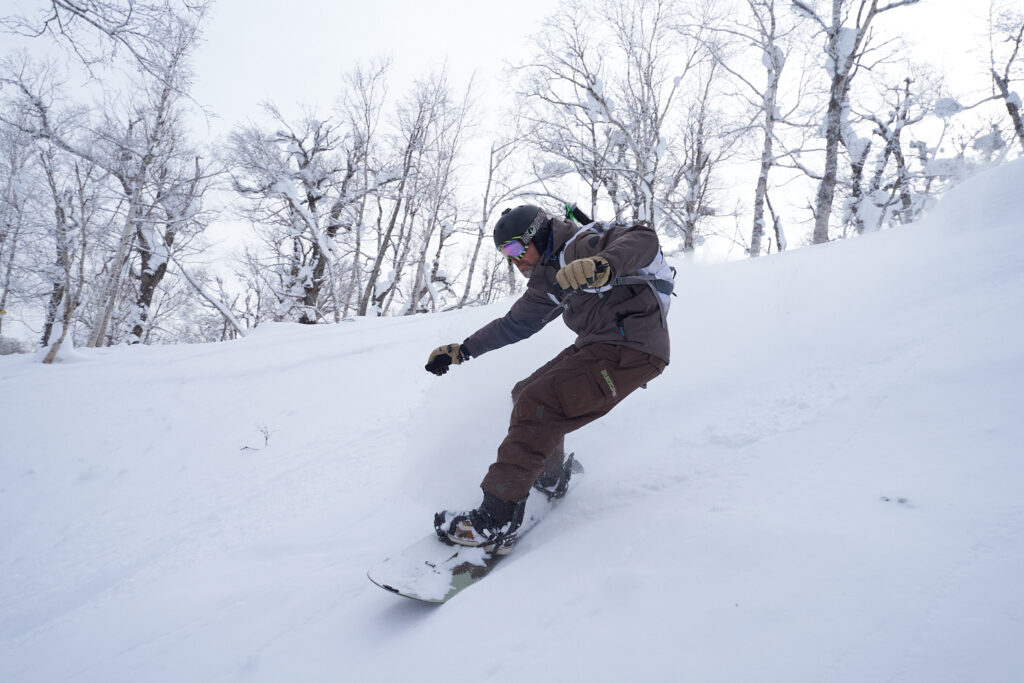
Surprisingly, the Weston splitboards didn’t feel like a compromise on the descent. Image: Aron Tarjani
Snow conditions weren’t perfect, but there was a little bit of powder on top of a hard base, and it was surprising how good the snowboards and bindings felt. I was expecting to feel some kind of compromise, but the Spark bindings felt responsive, and there was no real way to tell that the board was a splitboard.
We did three laps, never walking for more than an hour, with the runs down taking just a few minutes. Compared to downhill skiing in the resort, you hardly get any riding time, but you can’t compare spliboarding in those terms. It’s like the difference between scuba diving in a swimming pool or on a tropical reef.
The other huge upside of using a splitboard is that you don’t have a giant pair of snowshoes on your back for the descent. This is the worst part of snowshoeing, as it impacts your balance and enjoyment on the way down. With a splitboard, the only extra weight is the skins and the collapsible poles, which you don’t notice if you’re used to carrying a pack.
This was our first time, so the idea was to keep it mellow, both up and downhill. On a day where snow conditions weren’t perfect, it felt good to get away from the resort and be alone on the mountain – we didn’t see another group for the whole day.
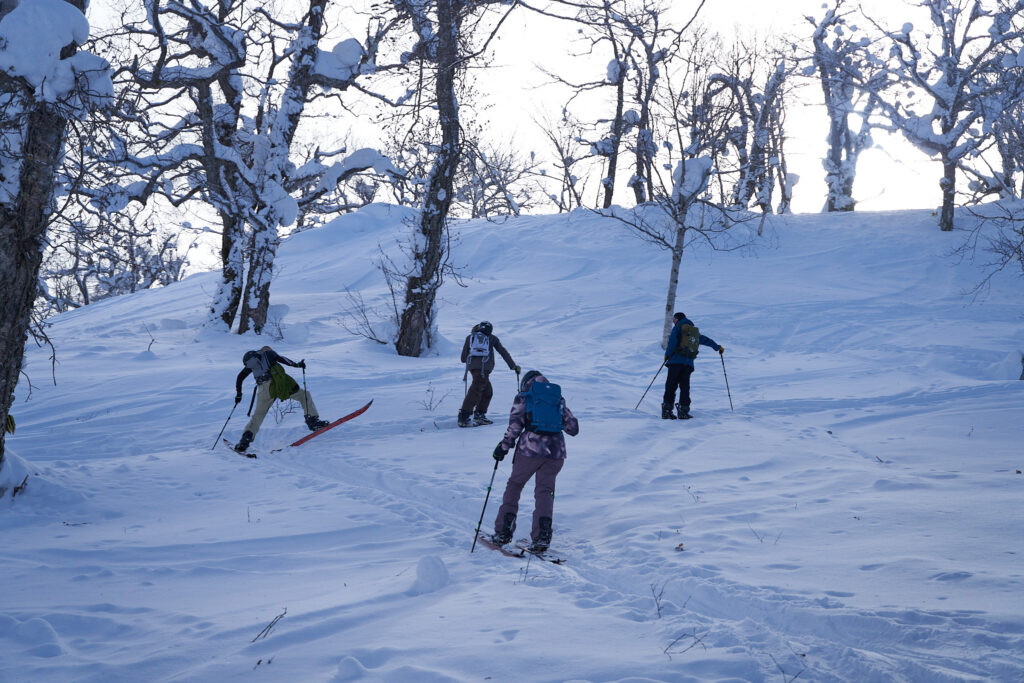
Getting to grips with kick turns. Image: Aron Tarjarni
It all felt easy up until now, as the gondola had done most of the work for the first run. Now we had to walk back up again. Even after a short run down, it’s slow progress getting back up again. It was good to try out kick turns in these conditions rather than deep snow, as this is probably the most challenging part of learning how to use a splitboard.
You need a different mindset when you’re starting out in the backcountry compared to resort skiing and riding. Essentially, you’re out for a day of 90% climbing hills, 10% riding down hills. You’ve got to be fit, preferably injury-free, and of a mindset where you can enjoy the effort and the scenery without getting antsy about missing out on lapping lots of runs.
Greg was very friendly and patient with us. Taking time to show us how to transition and giving tips on form. He was careful to understand our needs and make sure we got an easy introduction to splitboarding. The terrain was nice and open, and we didn’t feel any danger. It was a fairly relaxing day with just the right amount of uphill touring for our group.

Around here, when the sun goes down, the storm clouds roll in. Image: Robin Watts
As part of the tour, Greg took us to Kokusetsu Ashibetsu Ski Area on the way back, a nearby permanently closed ski resort, for a quick look at the 88-metre-tall Dai Kannon of Kita no Miyako statue, the third tallest statue in Japan and 10th tallest in the world. Some people had hiked up the slope to ski down, and we spotted a herd of deer on the hill.
We then stopped off at the Ashibetsu Onsen Starlight Hotel for a soak in their outdoor onsen, this time spotting a fox in the woods as it started to snow heavily.
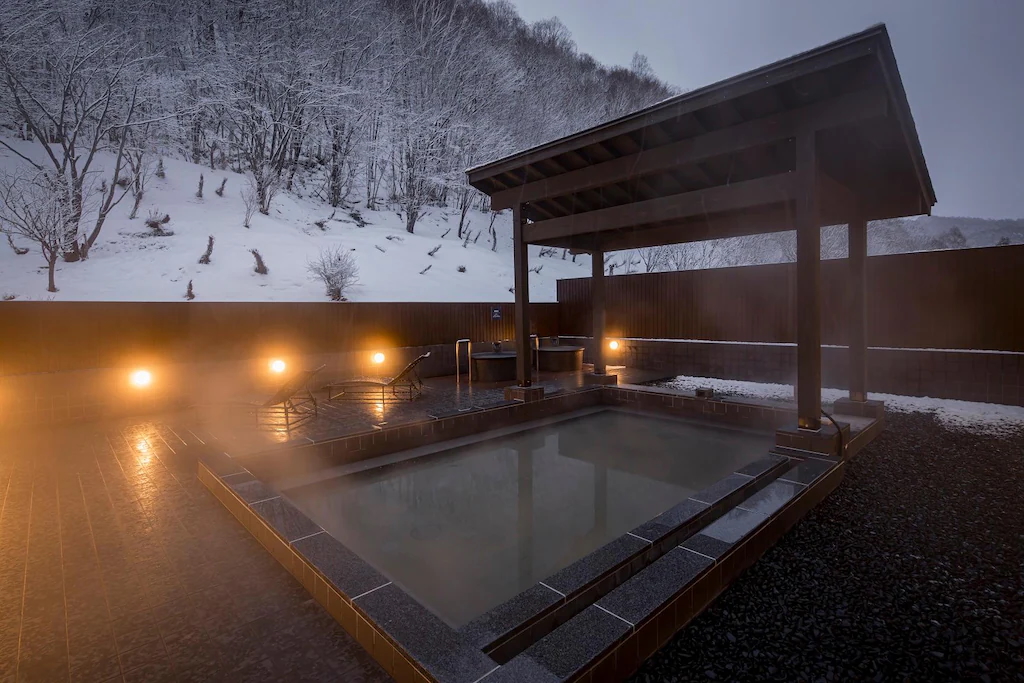
Ashibetsu Onsen Starlight Hotel’s outdoor onsen. Image: agoda.com
Tour 2: Kiroro Backcountry
Our second day with Whiteroom was planned as in-bounds guiding at Rusutsu to explore the tree runs, as we would then be staying close by in Kutchan. Again, this didn’t work out, as Rusutsu was heavily tracked out after a couple of days without significant snow. However, the news from our guide, Ronan Maguire, was that Kiroro, just 50km away, had received a big dump overnight.
After a quick stop in Niseko to set us up with the same backcountry kit, Ronan drove us the hour’s ride to Kiroro and issued us with passes for the gondola ride up to the backcountry gate at Nagamine peak. (There’s no need to submit a climbing plan despite what it says on Kiroro’s website.)

Ronan led us along a flat ridge to a drop-in point just 15 minutes from the gate. Image: Robin Watts.
The views out across towards Otaru, Ishikari Bay, and the Sea of Japan were breathtaking. We had a pristine 200m descent in front of us with a max 40-degree slope, averaging at about 29 degrees. Not a bad way to start the day.

Stunning views across the Sea of Japan. Image: Aron Tarjani
One of the best things about backcountry touring is the isolation. It’s a completely different feeling to being within a resort, even when you’re alone in the trees. In a resort, there’s always the knowledge that you’re in a managed environment along with other paying guests, and you’re making your way towards the base of a lift. You aren’t entirely free, though you’re doing your best to convince yourself that you are. The lifts, toilets, signage, ropes, restaurants, bars and mountain rescue all let you know that you’re in a “resort”.
“One of the best things about backcountry touring is the isolation. It’s a completely different feeling to being within a resort, even when you’re alone in the trees.”
When you leave the security of the resort behind, the mix of fear and excitement you feel is exhilarating. It feels like exploring rather than being penned in.
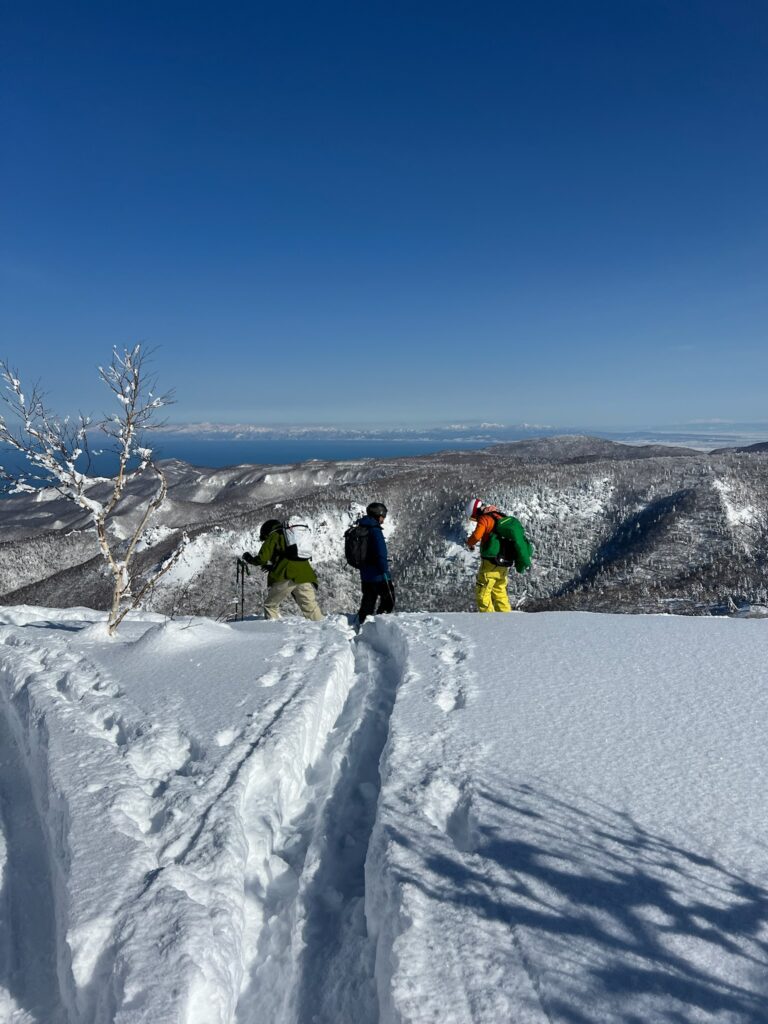
Ronan chose a spot with an open route down with large gaps between the trees. Image: Robin Watts
The snow was easily knee-deep once you stepped off the splitboard. After transitioning, we agreed to go one by one and stop at a safe spot once it flattened out a little about halfway down.
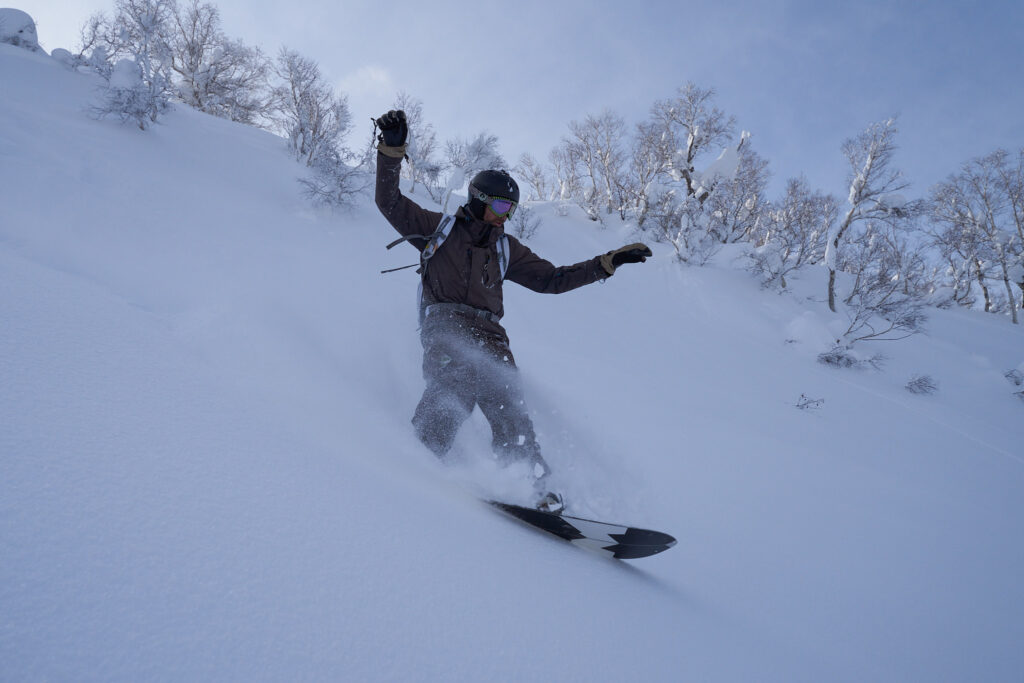
Aron
The run was unreal. The stuff of dreams. Deep but not too deep, fairly steep and super-light crystalline powder that just fluffed up in your face like smoke. After 30 years of skiing and snowboarding, this is as good as it gets.

My face after the first run (I didn’t fall, that’s just faceshots!). Image: Robin Watts
We then did another two laps in the same area. There was no need to stray too far into the backcountry, as there was nobody else around and the terrain was perfect.
Of course, the downside of steeper runs is a steeper walk up, and it’s safe to say this was pushing beyond my comfort zone. I was nursing a blister from new boots, I was shattered, but I still had the time of my life.
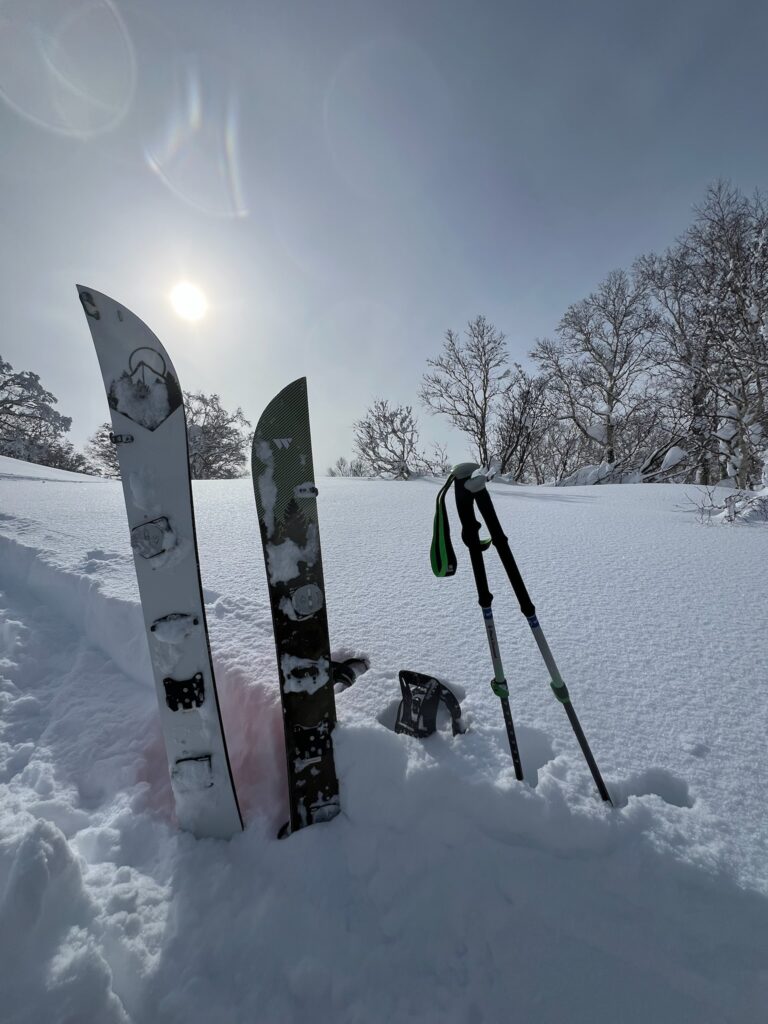
A perfect bluebird powder day at Kiroro. Image: Robin Watts
One very technical part of splitboarding is going downhill in touring mode. At certain points when walking uphill, you’ll need to negotiate a slight downhill section. When this happens in deep snow with a deep track on a steep slope, it’s tricky to keep your skis on the track. The inevitable fall is costly – both in terms of the energy expended standing up again, then cutting your own track to try to rejoin the existing track, and all the snow that gets inside your gear because you’re not wearing your jacket. I would like to have practised this a bit in a more controlled environment before trying it in the wild. I’ve skied, which helps, but controlling the skis while only having them attached to your toe is something that takes a bit of getting used to.
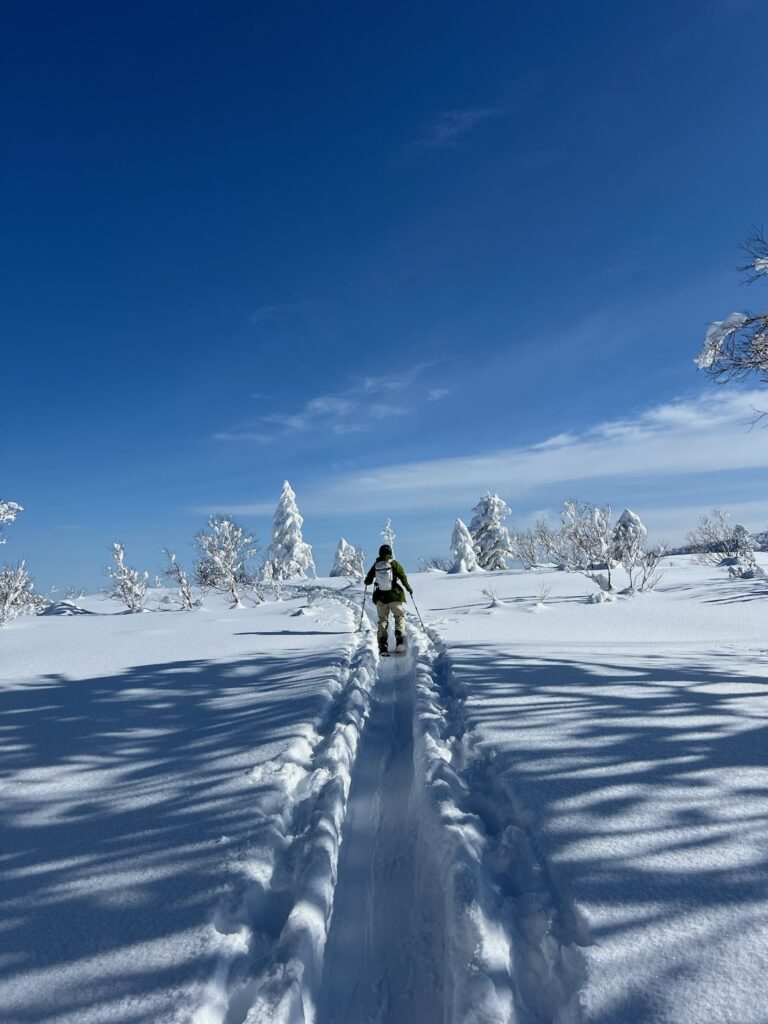
Trekking back to the resort. Image: Robin Watts
The best backcountry in the world?
Japan – and Hokkaido specifically – is right up there as one of the best places in the world for backcountry skiing and snowboarding. Why? The fact that it’s still quite a niche activity in Japan, and many locals stay on the pistes. The amazing terrain and breathtaking views. The reliable deep, dry powder.
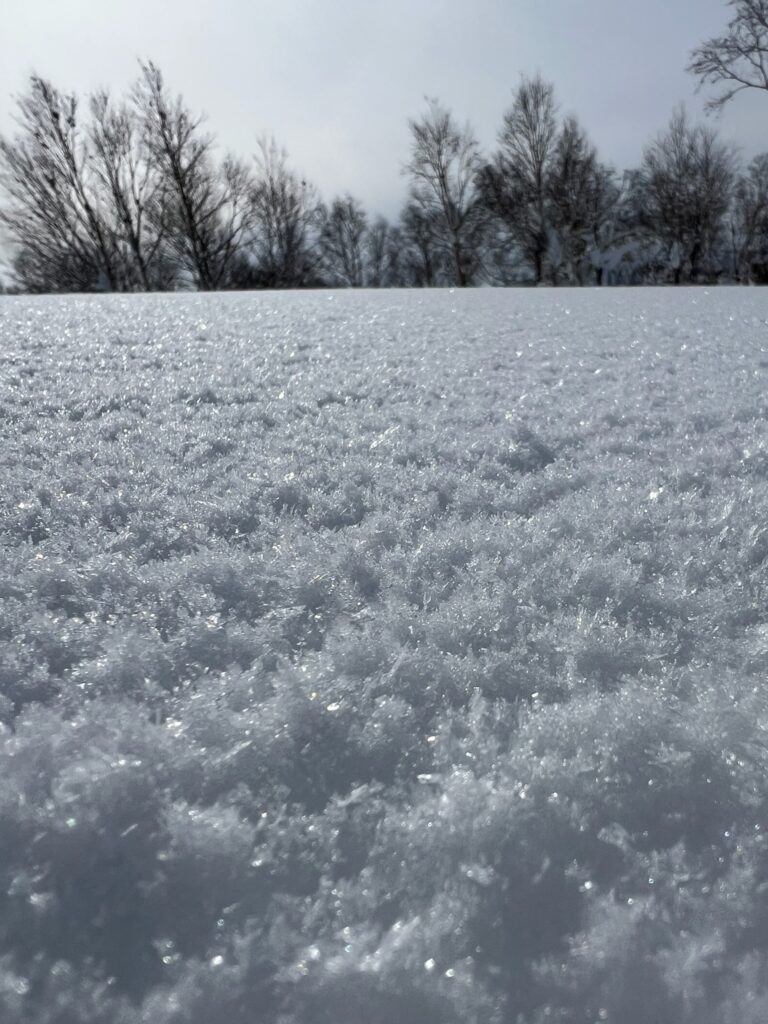
The snow at Kiroro was wonderfully crystallised and ultra-light with low moisture content. Image: Robin Watts
And, while going beyond the resort boundaries always has its dangers, the snowpack is generally more stable in Japan compared to Europe or North America (however, this fact can be dangerous in itself when tourists become overconfident). It’s by no means risk-free, but if you’re a tiny bit afraid of the backcountry yet still eager to try it, Japan is the perfect place to do so with a friendly, experienced, accommodating, and qualified guiding outfit like Whiteroom.
Once you’ve experienced this, it’s hard to go back to riding the pistes.
YOUR CHANCE TO WIN
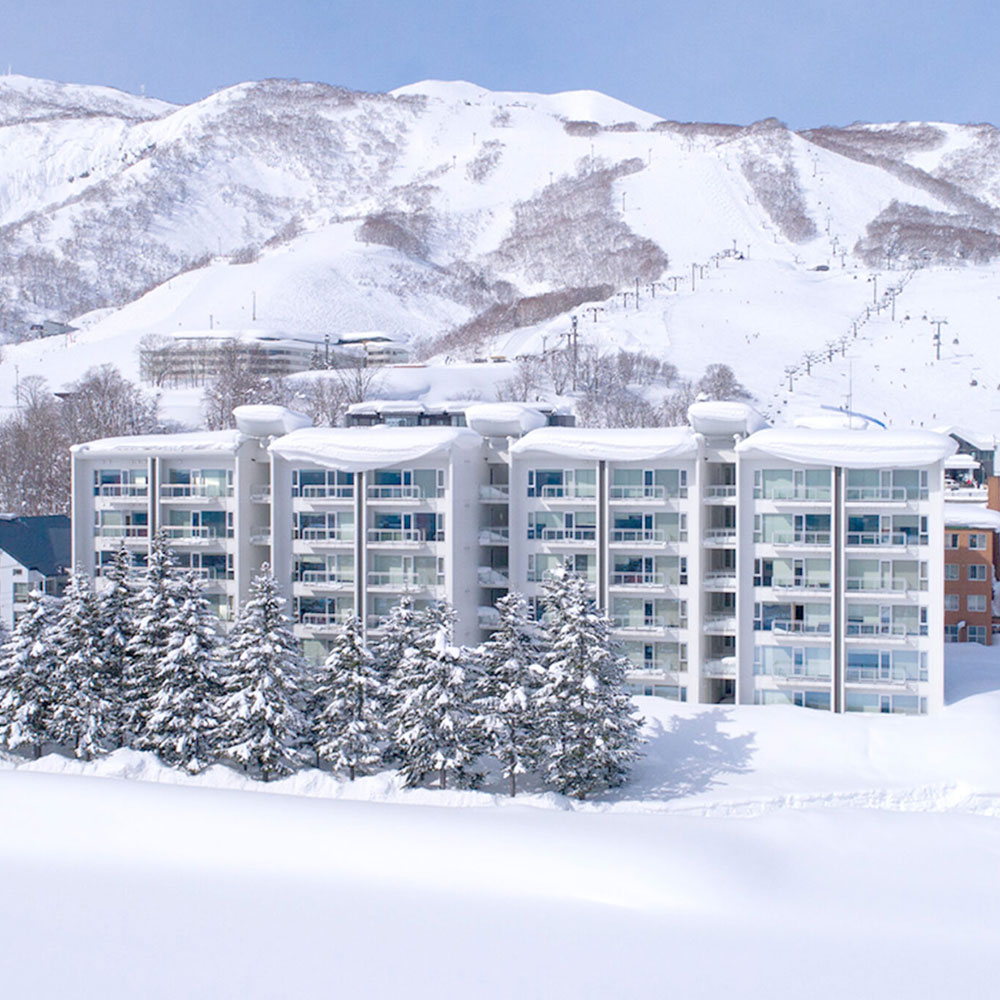 Win a 4-night stay in Niseko, Japan
Win a 4-night stay in Niseko, Japan
we have partnered with Vacation Niseko to give you the chance to win a 4 night stay for up to 4 people at the Niseko Grand Hirafu ski resort! Nestled in the heart of the action, your stay includes easy access to the slopes and Vacation Niseko’s signature local support.
Enter in seconds


AloJapan.com